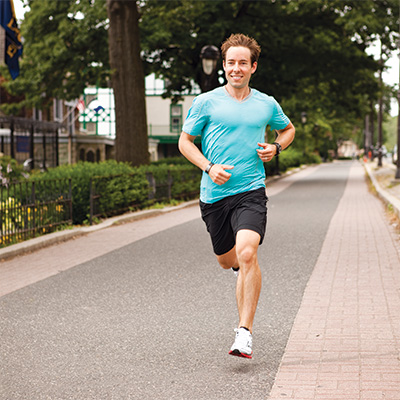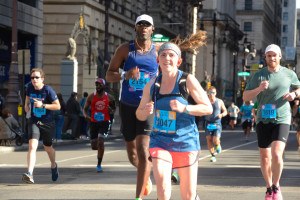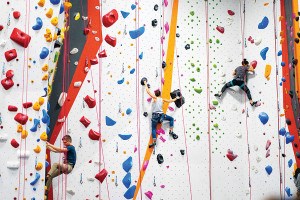Best of Philly Snapshot: John Goldthorp, Best Running Coach
To make me a better runner, John Goldthorp is making me roll around on the floor. Curious daytime gym-goers are staring as I struggle—truly, truly struggle, like a two-month-old—to roll from a supine position over to my belly without using my legs. This is a core reawakening, Goldthorp tells me. It’s much harder than I expect.
Of course, I wasn’t sure what to expect from Goldthorp, the spiky-haired, 36-year-old running coach and personal trainer at Optimal Sport Health Club, a gym in the basement of the Curtis Center. Goldthorp’s become something of a miracle worker for clients suffering from chronic stress fractures or personal records that haven’t budged in three years. His devotees run the gamut, from a 66-year-old who wanted to win his age division in the Boston Marathon (he came in third, but isn’t done yet) to a woman who worked her way from limited post-surgery mobility to a half-marathon training plan.
I was curious about his lauded techniques, but didn’t really think I needed his help. I’ve been running consistently for the past dozen years, and while I’m not picking up the speed I once did, I figured my fundamentals would be fine.

Photograph by Dominic Episcopo
But as Goldthorp tells me when I arrive, very little of a first meeting with a client has anything to do, directly, with running. “What we’re doing is looking for holes,” he says — holes in strength and muscle functioning, holes in training. “I look for weak links. Could be how you’re training, how you’re moving, even how you’re living.” This powwow is how he begins his work with each client. What follows is up to the runner, whether it’s a simple training plan or a weekly running session under Goldthorp’s careful eye.
Goldthorp took some notes on my history (long, with lots of ruts and injuries), my running routine (spotty), and my goals (today? Not getting fat), then got me started on the Functional Movement Screen — a physical evaluation of the presidential-fitness-test variety that he uses to hone in on his clients’ basic malfunctions. (He’s also been studying neuro-kinetic therapy, a technique for figuring out what muscles are compensating for what movement dysfunction and retraining them to respond to stimuli properly.)
“Generally, people are weak,” he says cheerfully. “But what they want to do requires strength as a foundation. A half-marathon is thousands of reps, if you think about it. And yet most people can’t do a single-leg squat with good control.” (I couldn’t.)
Goldthorp breaks running down to a practically molecular level—the rolling he had me do was actually to address the fact that I can’t touch my toes, signaling core instability. It’s pretty fascinating stuff to learn about how your body works, even if, like most runners, I’ve always been more interested in just running, as opposed to, say, my hip flexors’ range of motion. But that may be the genius of Goldthorp’s strategy — forcing patience and control on people who would much rather disregard their physical limitations completely.
“A lot of times, it comes back to doing the basics very well,” Goldthorp says. “You have to focus on quality, then build quantity. I’m a big fan of progression.”
And when progress begins on the floor? Clearly, there’s nowhere to go but up.
See the rest of our Best of Philly picks in the August 2014 issue of Philadelphia magazine, on newsstands now, or subscribe today. Then join us at the Best of Philly Bash at Citizens Bank Park on August 12th!
Like what you’re reading? Stay in touch with Be Well Philly—here’s how:
- Like Be Well Philly on Facebook
- Follow Be Well Philly on Twitter
- Follow Be Well Philly on Pinterest
- Get the Be Well Philly Newsletter


